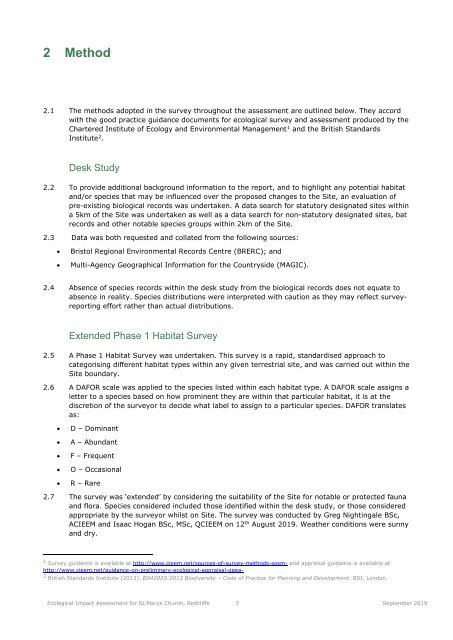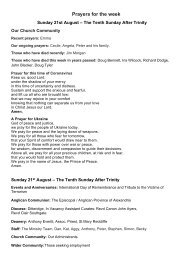St Mary Redcliffe Ecological Impact Assessment
Create successful ePaper yourself
Turn your PDF publications into a flip-book with our unique Google optimized e-Paper software.
2 Method<br />
2.1 The methods adopted in the survey throughout the assessment are outlined below. They accord<br />
with the good practice guidance documents for ecological survey and assessment produced by the<br />
Chartered Institute of Ecology and Environmental Management 1 and the British <strong>St</strong>andards<br />
Institute 2 .<br />
Desk <strong>St</strong>udy<br />
2.2 To provide additional background information to the report, and to highlight any potential habitat<br />
and/or species that may be influenced over the proposed changes to the Site, an evaluation of<br />
pre-existing biological records was undertaken. A data search for statutory designated sites within<br />
a 5km of the Site was undertaken as well as a data search for non-statutory designated sites, bat<br />
records and other notable species groups within 2km of the Site.<br />
2.3 Data was both requested and collated from the following sources:<br />
• Bristol Regional Environmental Records Centre (BRERC); and<br />
• Multi-Agency Geographical Information for the Countryside (MAGIC).<br />
2.4 Absence of species records within the desk study from the biological records does not equate to<br />
absence in reality. Species distributions were interpreted with caution as they may reflect surveyreporting<br />
effort rather than actual distributions.<br />
Extended Phase 1 Habitat Survey<br />
2.5 A Phase 1 Habitat Survey was undertaken. This survey is a rapid, standardised approach to<br />
categorising different habitat types within any given terrestrial site, and was carried out within the<br />
Site boundary.<br />
2.6 A DAFOR scale was applied to the species listed within each habitat type. A DAFOR scale assigns a<br />
letter to a species based on how prominent they are within that particular habitat, it is at the<br />
discretion of the surveyor to decide what label to assign to a particular species. DAFOR translates<br />
as:<br />
• D – Dominant<br />
• A – Abundant<br />
• F – Frequent<br />
• O – Occasional<br />
• R – Rare<br />
2.7 The survey was ‘extended’ by considering the suitability of the Site for notable or protected fauna<br />
and flora. Species considered included those identified within the desk study, or those considered<br />
appropriate by the surveyor whilst on Site. The survey was conducted by Greg Nightingale BSc,<br />
ACIEEM and Isaac Hogan BSc, MSc, QCIEEM on 12 th August 2019. Weather conditions were sunny<br />
and dry.<br />
1 Survey guidance is available at http://www.cieem.net/sources-of-survey-methods-sosm- and appraisal guidance is available at<br />
http://www.cieem.net/guidance-on-preliminary-ecological-appraisal-gpea-<br />
2 British <strong>St</strong>andards Institute (2013). BS42020:2013 Biodiversity – Code of Practice for Planning and Development. BSI, London.<br />
<strong>Ecological</strong> <strong>Impact</strong> <strong>Assessment</strong> for <strong>St</strong>.<strong>Mary</strong>s Church, <strong>Redcliffe</strong> 7 September 2019


















